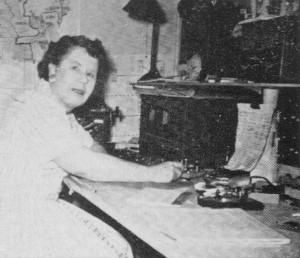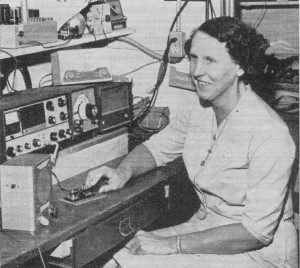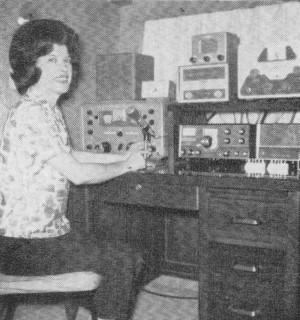October 1966 QST
 Table
of Contents Table
of Contents
Wax nostalgic about and learn from the history of early electronics. See articles
from
QST, published December 1915 - present (visit ARRL
for info). All copyrights hereby acknowledged.
|
"YL" is the shorthand used by amateur radio operators when
referring to female operators - Young Lady. Although still chosen as a hobby in larger number by men,
ladies have long been avid participants in the art/science of Ham radio. The American Amateur Radio
League's QST magazine devoted this "YL News and Views" column to their contributions many years ago
- trendsetting in its day. This particular issue introduces Louise Ramsey Moreau as its new editor.
Her interest in Ham radio was piqued when she realized "all the women heard on their receivers were
not 'just wives,' but licensed operators." The rest, as said, is history.
"YL News and Views" Articles in QST
magazine
April 1953 |
October 1953
| November 1953 |
December 1953 |
July 1966 |
October 1966

YL News and Views
Conducted by Jean Pecor, KIIJV, Editor
"The Lady That's Known as Lou"
 QST's new
YL Editor - Louise Ramsey Moreau, WB6BBO/W3WRE.
 Mary Lou
Stockstill, WN6SSZ (Photo courtesy of Braille Institute of America)

Flora Stroud, K7TFA
On many occasions you have read news of Louise Ramsey Moreau, "WB6BBO-W3WRE on QST's pages. Her outstanding
contributions to the amateur radio world have been many. It is indeed a pleasure to now introduce Louise
to all as the new YL Editor for QST.
August 1953 was the memorable month in which Louise and her OM, Bill, WB6BBL/W3WRC first became licensed
as Novices in Philadelphia. Amateur radio was to be Bill's hobby at the start, but Lou soon joined him
in learning code for she had suddenly discovered that all the women heard on their receivers were not
"just wives," but licensed operators. Lou joined Bill in studying, and both passed the exams.
Traffic hounds everywhere know of Lou's capabilities in this field. As W3WRE she was active on the
Western Penn. Net, 3rd Region Net, Eastern Area Net, and Transcontinental Corps. She also served the
area as Emergency Coordinator for Cambria County, later as Section Emergency Coordinator (AREC) West.
Penn. Section, and as State Net Control for Penn. State c.w. RACES Net.
Since moving to California in 1962, Lou has been active on the Southern Calif. Net (SCN), Pacific
Area Net, 8 Ball Traffic Net (v.h.f.), Salvation Army Disaster Communications Net, and has served as
manager of the 6th Region Net since 1963.
Lou's official appointments include Official Relay Station, Official Phone Station, Route Manager,
National Traffic System Manager. She was awarded ARRL's Public Service Award for her assistance during
the Alaskan Earthquake emergency, is an A-1 Operator, and has earned the Traffic Bronze Medallion (it's
rare when the BPL listing does not include her call).
Her antique collection of telegraph keys and equipment is also well known as she now has over one
hundred keys in the collection. The earliest dates back to 1850.
For the past three years, Lou has been working with W4MLE on the about to be published The Radio
Amateur's Operating Manual (see Sept. 1966 QST, page 10). She has also contributed several articles
to QST in the past, and received Honorable Mention for her ARRL Golden Anniversary Essay Contest article.
Lou was a member of the Conemaugh Valley Amateur Radio Club in Johnstown, Penn., and is presently
affiliated with ARRL, YLRL, LA-YLRC, Ramona Radio Club, Grand Chapter Morse Telegraph Club, Antique
Wireless Association, De Forest Pioneers and is a graduate of the University of Pittsburgh. Her OM,
Bill, WB6BBL is now employed at California's Institute of Technology's Jet Propulsion Laboratory.
The new YL Editor's first column will appear in the November issue. May it prove as rewarding an
experience to her as it has been for me. I'm sure all amateurs join me in wishing her the greatest success.
Impossible? Nothing is! The amazing story of Mary Lou Stockstill, WN6SSZ. of Canoga Park, California
well bears out this theory. With physical handicaps quite similar to those of Helen Keller to conquer.
Mary Lou, handicapped by the loss of both sight and hearing, has recently taken and passed the FCC Novice
examination. She is the first such woman to achieve this distinction.
While attending Earlham College in Richmond, Indiana, Mary Lou won the admiration of a young University
of Indiana engineering student, Charles Stockstill, and they were married in November 1954. Born in
Marion, Indiana. Mary Lou lost her sight at the age of ten as a result of a combination of childhood
diseases. When she was considered well enough, she entered the Indiana School for the Blind where she
studied both piano and organ. While a student in high school, she earned the Kiwanis award for the best
all around student in the senior class.
Charles and Mary Lou now have two pre-teenaged daughters. A year after the birth of their second
child, Mary Lou discovered that she was losing her sense of hearing. Doctor after doctor advised her
that not much could be done about a nerve type loss of hearing. In 1961. the Stockstills left Indiana
and headed west for a new start in California. Charles went to work for the Rocketdyne Company in Canoga
Park, and Mary Lou attended the Braille Institute of America, Inc. at Los Angeles for weekly classes
in knitting and mosaic tile.
Mary Lou Stockstill - WN6SSZ
Mary Lou's interest in amateur radio came about quite by accident. During a demonstration of a device
known as the "Tactile Speech Indicator" tested in September 1965 in a project which was sponsored by
the San Fernando Valley State College, she learned the value of signals by code. In a Leadership Training
Program in the Area of the Deaf, Dr. Ray L. Jones, Project Director, and Mr. Hugh L. Moore, an Electronics
Specialist for the Los Angeles City Schools tested the device with three highly intelligent deaf-blind
men. Results indicated that persons handicapped by the loss of sight and hearing were able to communicate
by telephone by use of "yes" and "no" signals. It was also discovered that one familiar with the Morse
Code was able to carry on quite a conversation. Realizing that the Braille Institute also sponsored
a class in amateur radio, Mary Lou decided to enter a third class of instruction.
Although unable to make intelligence out of any type of conversation involving the spoken word, mother
nature has provided Mary Lou with the ability to hear high-pitched tones which fall in a narrow region
above and below the frequency of one thousand cycles. The normal frequency of tones emitted by the human
voice ranges from just below three hundred cycles to the upper limits of around three thousand. Therefore,
the spoken word is just a jumble of sounds, but radio signals from amateur or commercial radio stations
using the International Code for transmission of messages can be picked up by Mary Lou. In turn, she,
by use of the telegraph key for communication, may now spend many happy hours chatting with friends
via. the air waves.
In addition to radio code, there are several ways that others may communicate with Mary Lou. She
reads Braille and uses either a standard typewriter or Braille to correspond with friends. Another method
is to take her finger and using it as one would use a pen or pencil, print letters across the palm of
one's hand as though printing one letter on top of the previous one. Radio operators can tap out messages
in code on her arm or wrist.
Ray Meyers, W6MLZ, recently featured Mary Lou during his weekly radio program, "Calling CQ," over
station KPFK-FM. He also kindly sent the information which has made it possible to tell radio amateurs
everywhere the amazing story of Mary Lou Stockstill. Ray sponsors an organization open to sightless
amateur radio operators the world over called the International Handicapped Net. This net provides a
common meeting place for the members. Further details will gladly be furnished by contacting Ray Meyers,
W6MLZ.
Arizona's Flora Straud - K7TFA
Happiness is building a piece of ham gear, seeing no smoke during the smoke test, and having everything
work perfectly as per instructions. The end result is not only a better informed ham, but a happy one.
Flora Straud, K7TFA, will attest to that.
Flora's OM, Ken, K7TEZ, has been active in amateur radio for many years. Ken was first licensed as
3BUX in 1921. Flora's interest to also become licensed was quickly nurtured, and has resulted in another
outstanding XYL amateur.
It isn't often that an XYL builds her own complete station. The equipment shown in Flora's shack
(see photo) is the product of her capabilities. In addition, she also built her receiver as well as
various testing equipment. Her latest undertaking is the building of a Heathkit electronic keyer.
Flora is active mostly on 80, 40, and 20 meters, both on c.w, and phone. To QSO her would be more
than just contacting an Arizona XYL, which in itself is a rarity. You would also be talking with a "real"
ham.
YL Club News
YLRC of Los Angeles recently installed the following new officers for the coming year: Pres., WA6ISY;
V. Pres., WA6LWE; Rec. Sec., WA6ZTW; Cor. Sec. W6JCA; Treas., WA6UBU.
The San Diego YLRC announces their new officers as follows: Pres., WA6SKT; V. Pres., K6VRH; Treas.,
WA6CQS; Rec, Sec., WA6ATB; Cor. Sec., K6YIT; Cert. Custodian, WA6ATB.
The Ontario Trilliums, VE3TOT, announce another first for their newly formed club in being the first
Canadian YL group to participate in Field Day activities. Theirs is also the only report received from
any YL group who may have participated. Transmitters were set up in the Caledon Hills area where they
operated c.w. on 40 and 20 meters; phone on 2 meters. This being their first year, they operated to
gain experience. Jean Evans, VE3DGG, and Doris Cody, VE3BBO, were their Field Day Coordinators.
It is with deep regret that QST announces the departure of Jean Peacor, KIIJV, from the QST staff
of contributing editors. Fairness to the demands of a growing family makes it impractical for her to
continue as YL Editor. The column has grown and prospered under Jean's capable hands and we will miss
her informative, delightful, humorous, column "leads." Readers and Hq. staff say "well done," Jean.
"Good luck and 73!"
Posted March 8, 2019
(updated from original post on 3/20/2013)
|












